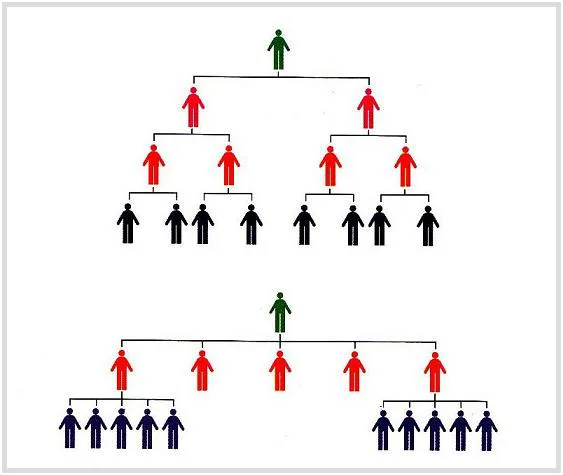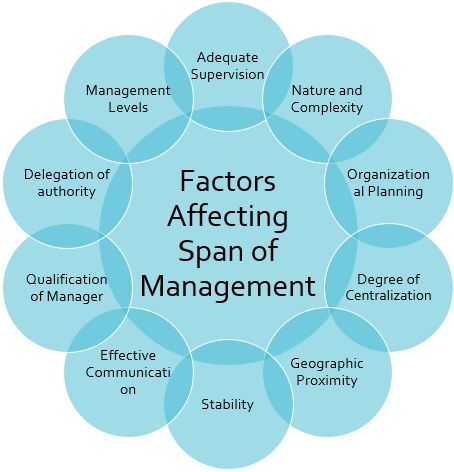
INTRODUCTION
Span of control, Span of supervision, Span of authority and Span of responsibility other names for Span of management. It indicates the number of people directly managed effectively by a single person. It is accepted that the large number of subordinates cannot of members is too large, it will be difficult to manage the persons and perform the work be supervised and their efforts co-ordinated effectively by a single executive. If the number of members is too large, it will be difficult to manage the persons and perform the work effectively. A sound organisation depends upon the effective performance of work by the executive. So, the executive should neither be overloaded nor be idle.
MEANING
Span of management means the number of people managed efficiently by a single officer in an organisation.
It implies that a single executive should not be expected to give guidance to more people. Only limited number of persons are allocated to the executive for dividing the work or duties among the workers. In order to avoid overburden to the officers, it is essential to determine the span of control of the executive officers. In an average firm, an executive can efficiently control upto five or six sub-ordinates. The limit of the number of members for span of control may be increased or decreased according to the levels of management. Normally the members exercising span of control are decreased at the top level management and increased at the bottom level management.
Many management experts suggested a different number of executives for effective control. According to L. Urwick, the ideal number of subordinates is four in case of higher level management and eight to twelve in case of bottom level management.
Check here for latest case studies and research book : https://kit.co/Anurooba/case-analysis-text-books
FACTORS AFFECTING THE SPAN OF MANAGEMENT

1. Character of the supervision work: The span of control may be increased whenever the work is performed and standardised. The reason is that, the supervisor has the opportunity to lay down permanent policies followed in an organisation. It results in the control of more number of subordinates. If the nature of work is a complicated one, the span of control has to be restricted.
2. Leadership qualities: The personnal abilities and capacity of a supervisor can influence the span of management. If the supervisor has more skill to control the subordinates, the span of management may be increased and vice-versa.
3. Qualities of the subordinate: If the subordinates have enough talent to perform the work assigned to them, the manager or the supervisor can control more number of subordinates.
4. Time available to supervisor: Most of the executives or supervisors will spend a lot of time for the operating work and administrative duties like planning and organising activities. They may supervise the subordinates in the remaining available time.
So, they can control lesser number of sub-ordinates than the person who spends full time for their supervision.
5. Nature of work: Some of the works are repetitive in nature and does not require any extra-ordinary talent to perform. In such cases, the supervisor or the executive can control a large number of subordinates.
6. Level of supervision: Whenever the subordinates perform the work manually, the span of control may be increased. It means that the degree of span of control can be increased at bottom level management and decreased at the top level management.
7. Delegation of authority: If the authority delegates the powers of decision making, planning and execution to the sub-ordinates, the span of control may be increased. Whenever an executive performs the planning and executive work in addition to supervision work, the particular executive can supervise relatively more number of sub-ordinates.
8. Fixation of responsibility: In case the responsibility of the sub-ordinate is clearly defined, he need not contact the superior for getting guidance and instruction. Then the superior can supervise large number of sub-ordinates.
9.Using of standards: Standards are used in an organisation to detect the errors or faults in the performance of work. So, there is no need for an executive to spend in watching the performance of the sub-ordinates. Then the executive can control more more time number of sub-ordinates.
10. Methods of communication: Method of communication is also one of the factors which determine the span of control. The method of communication may be divided into two i.e., Oral and Written. Oral communication requires more time and energy and these can be avoided in the written communication.
GRAICUNA’S THEORY OF SPAN OF MANAGEMENT
A management expert named V.A. Graicunas contributed much to the Span of Management Theory. His theory identified the relationship prevailing between the superior and the subordinates. The relationships are classified into three categories. They are given below:
1. Direct single relationships.
2. Direct group relationships.
3. Cross relationships.
The explanations of the above mentioned three relationships are given below:
1. Direct single relationship: Direct Single Relationship is one in which a supervisor has direct relationship with his subordinates individually. If A super-vises B and C who are subordinates, there are two direct single relationships.
2. Direct group relationships: In Direct Group Relationship, a supervisor has direct relationship with his subordinates jointly.
3. Cross relationship: In Cross Relationship, a subordinate has relationship with another subordinate mutually.
The number of direct and cross relationships increased geometrically as the number of sub-ordinates under the supervisor increased.
Formula
V.A. Graicunas prescribed the following formula to ascertain the number of superiors’and subordinates’ relationship.
Number of relationships = n(2n/2+n-1)
Where, “n” refers to the number of subordinates.

For example, the number of subordinates, say 5, the number of superiors’ and subordinates’ relationships are identified as under:
n = 5
Formula = n 2n/2+(n-1)
=5 x (2 x 2 x 2 x 2 x 2)/2 + (5-1)
= 5 x 32/2 + 4
= 5 x 16/4
= 5 x 20
= 100

The number of relationships increases in geometrical progression as shown in the following table.
| Number of Sub-ordinates | Number of Relationships |
| 1 | 1 |
| 2 | 6 |
| 3 | 18 |
| 4 | 44 |
| 5 | 100 |
| 6 | 222 |
| 7 | 490 |
| 8 | 1080 |
| 9 | 2376 |
| 10 | 5210 |
The effective supervision depends upon the efficiency of the supervisor and the number of sub-ordinates to be supervised. It is cleared from the above table that the number of relationships is increased correspondingly with the increasing number of sub-ordinates. The effectiveness of the supervision decreases if the number of relationships or sub-ordinates is increased. So, the management should fix the number of sub-ordinates to each supervisor according to the nature of work. If the management does so, it can get good results i.e., effective supervision.
0 Comments
13 Pingbacks